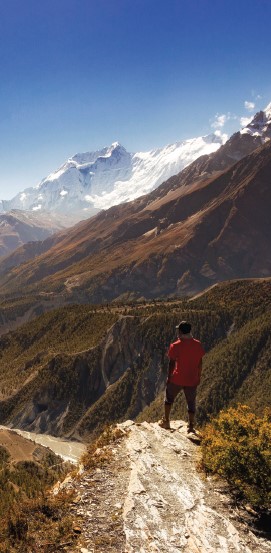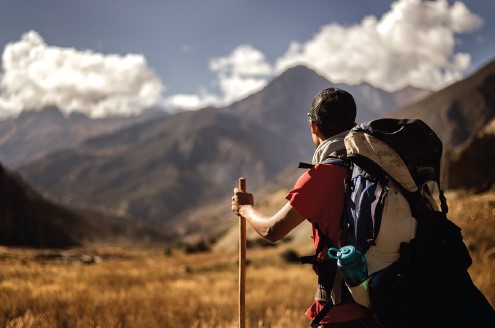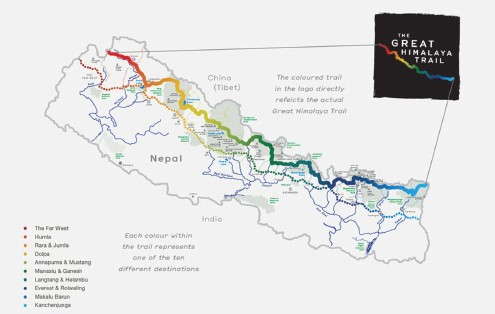 Sudin K.C. is setting out to experience his country—all of it—from the ground up.
Sudin K.C. is setting out to experience his country—all of it—from the ground up.
Have you heard of the Great Himalayan Trail? It’s the name for a general collection of routes that run across Nepal from east to west, a total of about 1500-1700 kilometers, depending on how you do it. More than just a specific single track, it’s a combination of many. There are high altitude paths one can take, as well as ones that stick to the lower districts, and a combination of the two. Many people choose to go as high as they can along the upper trail in order to experience the Himalaya up close. A few, though, are more fascinated by the lower routes that take them through places where they can interact with local people and villages, known as cultural trekking.
Sudin K.C. is a young photographer and explorer who will be setting out on September 1, 2018, to walk the length of the Great Himalayan Trail, mostly following this lower cultural route, staying in people’s homes as much as possible in order to better interact and discover. We sat down with him to learn more about the why and hows of this trip he’s planning.
What gave you the idea to do this?
Basically, I always had this idea of finding my roots, where I belong. Nepal is the country that I was born in, and I want to know about the country itself more, and the only way to actually do it is to visit everywhere I can. And because the Great Himalayan Trail offers the whole range….
The Great Himalayan Upper Trail is the higher one, most people do the upper, some people like to do upper and lower mixed, but what I’m going to try to do is just stick to the lower as much as possible, because that’s where my subject will be—people.
So, more than the mountains, you’re interested in the culture and people?
Yes, the people; their lifestyle, exploring how they live, their living conditions, and those kinds of things. So, more than mountains, it’s about people and culture.
How long do you think it’s going to take you?
Approximately, it should take 80-100 days.
Is this going to be only walking, or are you going to take any transportation?
To get to the start, I’ll go by bus or flight, but after that it’s just walk. It’s 1500 kilometers. My starting point will be Bhairahawa, according to the itinerary, but the zone is Kanchenjunga Zone. I’ll start in the Terai and then I’ll go up.
What’s your goal in all of this? What are you hoping to achieve or experience?
One thing I’m hoping to get out of this is self-exploration and knowing myself better, but also knowing the living conditions of fellow Nepalis better. And, if there’s some way I could understand what the challenges and problems they're facing are, and link them up to organizations that are working on those areas. For example, if some community is facing problems with education or health, I could link them up with organizations in Kathmandu who are doing that kind of work. So, in a way, it’s not just about myself, but more about the people there and trying to make their life better, as well. And, also to generate awareness amongst people worldwide that, ‘Hey, Nepal doesn’t just have Everest and Annapurna, but there are whole other mountains where you can go,’ and that in turn would support the tourism industry and local economy of the people there. That’s my hope, anyway.
No one has heard about the places that no-one has visited, so that’s my desire, to open [the knowledge of] those areas to people all over the world and let them know, ‘Hey, this is beautiful too; you can trek here, you can visit these places.’ I have no doubt that there are so many beautiful places outside of the popular destinations. Because that’s what’s happening—Everest region, like Naamche Bazaar, is one of the richest, or the richest, cities in the Himalayan range, because everyone knows Everest, and everybody goes there. And the porters, local guesthouse owners and workers, everyone has employment, and that town’s economy has been raised. But places like Darchula or Jumla, or other remote areas, people don’t want to go there because they’ve never heard of it.
It’s my hope that once they do hear about them and the stories do engage and they can relate to them, they can go visit there and the local economy can be raised. The people can benefit and the culture will be preserved, because they don’t have to move to another place. So, they can stay in their place, with their cultural customs and festivals, and continue with their values and norms, not having to move to the city and [potentially] forget all about it.
In my experience with Langtang, that was exactly what happened. After the earthquake, Langtang was no longer a popular destination to trek; it was [deemed] risky and all the youth came to Kathmandu, and what happened was that nobody was celebrating anything anymore and the culture was just—well, dying. And it’s sad, because when we interviewed the old people, they were really sad about it, because they want to celebrate Losar, they want to celebrate other festivals, too, but they don’t have people to celebrate with, because young people—well, they do need facilities like health, education, and roads, which is understandable. If they have a sustainable source of income, they can generate income among themselves, they wouldn’t have a need to move to Kathmandu. They would have desires and wants, but not need. Because, that’s what’s happening.


There’s a lot of insights in these words, and I’m excited to see where the path will take him, both externally and internally. Sudin K.C. told me that his grandfather’s grandfather moved to Kathmandu from somewhere; he asked his grandmother where from, and even she didn’t know. As we talk, it appears that this, as much as anything, may have been the deeper inspiration behind this young man’s planned trek, something inside of him that wants to know: what are his roots? Where does he come from? East or west Nepal? “I’ve got no clue,” he tells me frankly.
But, he believes that while there are good things to be learned from outside values, it’s vitally important to culturally look inward, as something that should be taken pride in. “If we don’t take pride in that, how can we preserve it?”
What answers will he find, and what experiences will he have on the trail? Keep a lookout, because we’ll be publishing some of his stories in the months to come, and I know that I for one can’t wait to hear what they will be.
You can follow his adventures on the Great Himalayan Trail in real time, too, at the links below from September 1, 2018 – his travel blog will be linked there as soon as the journey begins!
https://www.instagram.com/sudinkcphotos/
https://www.facebook.com/sudinkcphotos/










